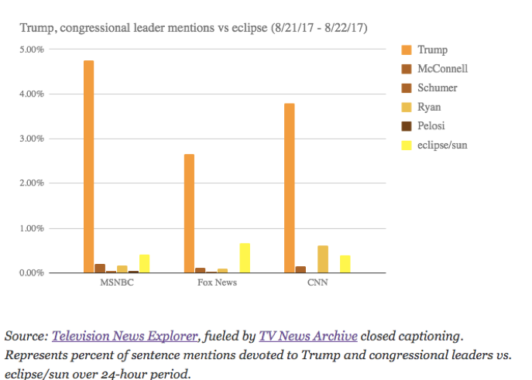
What can be said about President Trump that hasn’t already been said?
With an overwhelming amount of news media coverage devoted to his every comment—whether on Twitter or IRL—it’s hard to even imagine waking up to a headline that’s not about him.
And for the last year, we barely have.
Granted, he is our president. And there are a lot of important stories we need to hear that concern him both directly and indirectly. But Trump has become an inescapable part of Americans’ daily news diets, and we all know what happens when we eat too much: indigestion, fatigue, loss of appetite.
Aside from our collective stomach ache, Trump oversaturation has clear implications for the impact of other (also important) stories: The messages simply aren’t getting through. Those who have tried to find Trump-free zones in the press have come up short. “He has taken up semi-permanent residence on every outlet of any kind, political or not,” writes Farhad Manjoo in the New York Times. “He is no longer just the message. In many cases, he has become the medium, the ether through which all other stories flow.”
Manjoo notes that in January, Trump broke the records for MediaQuant, a firm that measures “earned media,” which includes brand mentions across both traditional and social media. Not only had Trump gotten more coverage than other famous individuals, but more coverage than the next 1,000 famous people put together. The always-on, echo-chamber nature of social media further amplifies coverage, Manjoo observes. “Every story that shows any signs of life on Facebook or Twitter is copied endlessly by every outlet, becoming unavoidable.”
Even reporting on this season of unusually destructive hurricanes and their aftermath has faded in the face of the latest incendiary presidential tweets.
And, well, let’s face it: If a once-in-a-lifetime solar eclipse can’t get our attention, neither can a security breach that exposed the Social Security numbers and other data belonging to 145 million Americans.

What’s really heartbreaking is that only the most egregious of stories seem to break through Trump TV. The shooting in Vegas—one of the most fatal in U.S. history—rose to the top of the headlines briefly but quickly receded. (Whether that’s related to the absence of a known motive, or the seemingly endless stream of grief, prayers, outrage, calls for gun control, and, eventually, inaction, we’ll never know.)
And then of course there’s the #MeToo movement. Earlier this fall, after allegations against film executive Harvey Weinstein came to light, actress Alyssa Milano encouraged women who had been sexually harassed or assaulted to share their stories using the #MeToo hashtag. It has been tweeted more than half a million times. Since then, people in entertainment, media, tech and, sadly, government, have come forward with horrifying accounts of harassment and assault. (And it’s interesting to note that this is the one story Trump has not tweeted about or mentioned in any way.)
Widespread burnout
So what does this all mean exactly? The deluge of news about Trump’s erratic and unprecedented behavior is taking a toll on news consumers. Psychologists such as Steven Stosny report a spike in patients reporting anxiety about politics. “Our current environment, amplified by 24-hour news outlets and social media, has created a level of stress, nervousness, and resentment that has intruded into many people’s lives and intimate relationships, the likes of which I’ve not seen in nearly 30 years of clinical work,” he wrote in April.
It’s also wearing through the nerves of reporters. Journalists are suffering from the break-neck pace of all-Trump, all the time. On the one hand, Trump is helping to make journalism great again; more foundations are investing in nonprofit news. But on the other hand, the pace seems unsustainable, adding insult to injury in an unstable industry that was already a bummer. Lee Drutman of Vox enumerates the symptoms of Trump scandal fatigue: numbness, disengagement, losing touch with reality, and grasping at flashes of normalcy.
“I’ve been laid low by what Hollywood screenwriter Sam Friedlander has diagnosed as Trump-Induced Anxiety Disorder,” wrote Miami Herald columnist Fred Grimm in May. “For someone like me, addicted to political news, the stuff cascading out of the White House these past few weeks has been like capping off a yearlong bender with a visit to a crack house. I’ve taken on the physical aspect of a fentanyl zombie, staring with raccoon eyes at my computer screen, bouncing back and forth between the Washington Post and New York Times websites, then over to McClatchy, Politico, The Hill, Naked Politics, Mother Jones, New Yorker, Drudge, Atlantic, Weekly Standard.”
Even comedy writers are feeling the burnout. “[Trump] moves so fast that there’s no real point in spending a month on something that he’s said until you work out what the consequences of that are going to be,” John Oliver told Paste in February. His strategy? Trying to find other stories that are not quite so picked over.
What can funders do?
In this raucous and incessant information environment, how can funders best support grantees, journalists and themselves?
Keep supporting alternatives to the all-Trump, all-the-time press.
Funders have recently supported a range of recent efforts related to news, trust and information. For example:
- The News Match, jointly funded by Knight, the Democracy Fund and the MacArthur Foundation, is designed to build the field of funding for nonprofit news, and increase capacity for individual outlets. Find out how to get involved.
- Knight also just launched a new Commission on Trust, Media and Democracy.
- The News Integrity Initiative announced a slate of $1.8 million in grants to build public trust and engagement in news.
- The Omidyar Group and Democracy Fund jointly released a paper exploring ways that social media has become a threat to democratic ideals.
- The Lenfest Institute for Journalism is offering grants for innovative projects that engage and inform local communities.
- Report for America is a public-service program supported by the GroundTruth Project and Google News Lab whose goal is to place 1,000 reporters in local newsrooms across the country over the next five years.
- ProPublica has launched the Local Reporting Network, which will support the addition of one full-time investigative reporter in each of the nonprofit’s six partner news organizations in cities with populations under one million.
Invest in media makers’ self-care.
Organizations such as Columbia University’s Dart Center for Journalism and Trauma are focused on mitigating the most dangerous aspects of reporting, and the recently released Safe + Secure handbook, supported by an array of funders, offers resources to counter the risks that muckraking documentarians face. But there are stressors even for those who stay in the newsroom, as reflected by the upcoming SRCCON Work conference in December, which includes a strand on mental health and self-care.
Don’t take the bait, but don’t give up, either.
Trump’s communications style is agitation, incitement and distraction. And that makes people—on both sides of the political aisle—angry. But in order to avoid another violent clash like Charlottesville, we need to engage not just the far-left antifa activists. “The most important principle is strength in numbers, and not leaving it to the most targeted communities to be the only ones standing up to these forces,” says The Nation contributing editor Naomi Klein.
Thankfully, there are a number of organizations working on effective counter-strategies. The Fightback Table—a partnership between Color of Change, MoveOn and others—is exploring nonviolent tactics that include building alliances with the center-right and leveraging more people to push legislative action.

